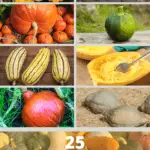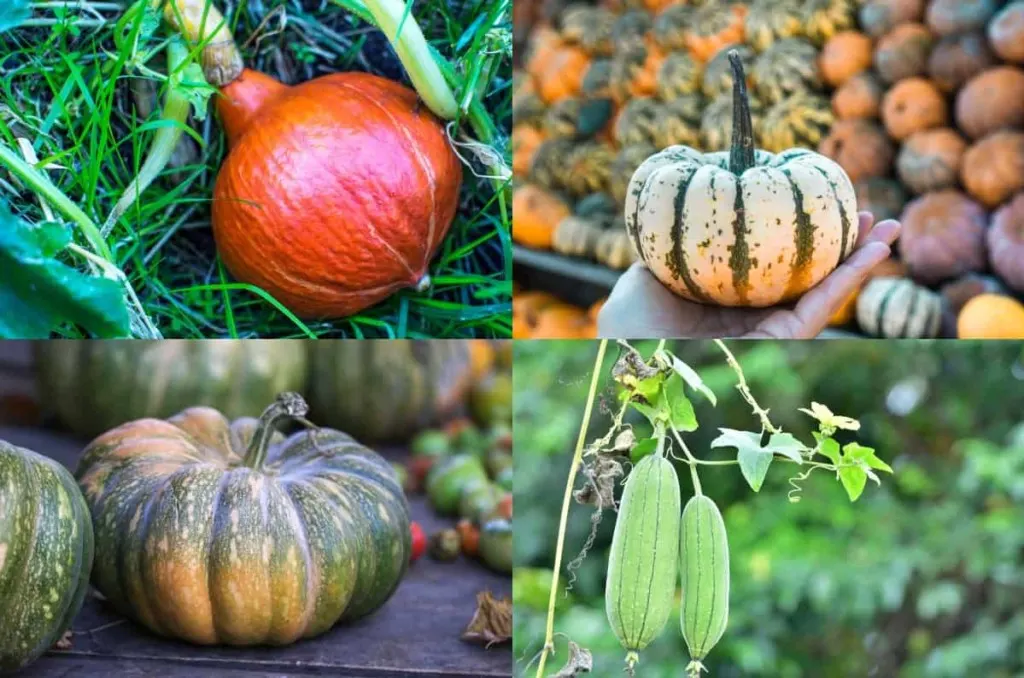
Growing squash in your garden can be a wonderful way to boost your yield and grow food to last you all year round.
Choose the right varieties and you can be harvesting summer squash all through the summer and into fall, and then have winter squash and pumpkins in store to see you through the winter months.
There are a huge range of squash that you could choose from, though which will do well will obviously depend on where you live, and the conditions that are to be found there.
You may not be able to successfully grow all of these types of summer squash, winter squash and pumpkins in your garden.
But it is likely that at least a few of the types listed below will be suitable for you to try.
And those that aren’t will likely be available at your local farmers market or grocery store for you to try eating.
Tips for Choosing Squash Types
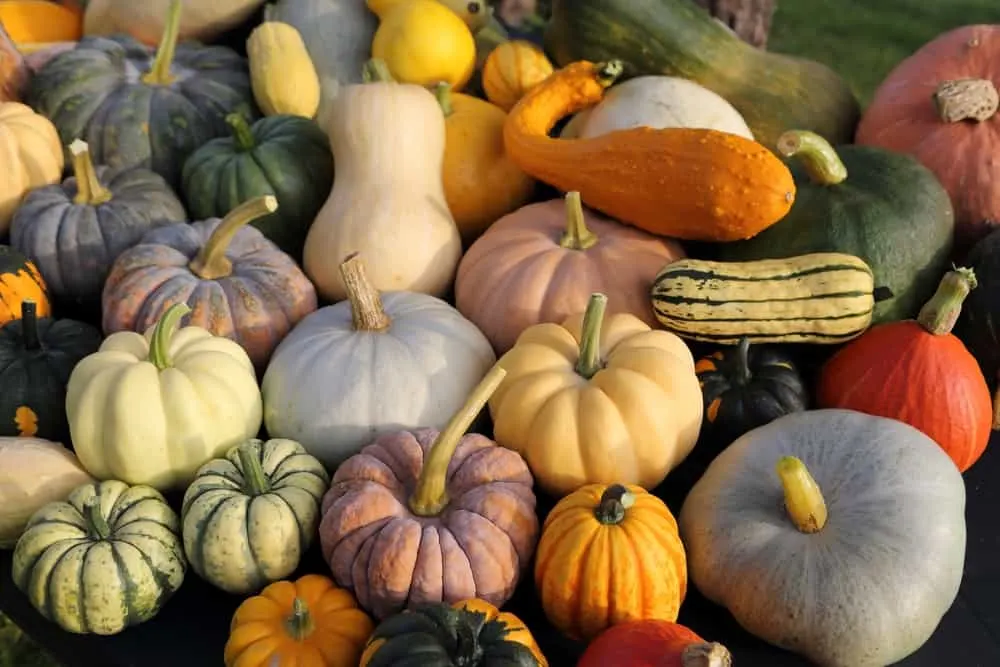
Before we go on to discuss a number of different squash types that you might be able to consider, there are a number of things to think about. Firstly:
Choosing Types of Squash for Your Area
Where I live, for example, there is a relatively short growing season. This restricts the varieties and types of squash that can be grown here.
However, by choosing varieties that have been specifically bred for my region, and for a short growing season, I am able to gain a worthwhile harvest of certain squash types.
I also increase my chances of success by growing squash in my polytunnel, under cover. This extends the season a little and offers the plants and fruits a degree of protection.
Wherever you live, it is important to employ the same techniques.
Always try to choose options that are suited to your region, and, ideally, seeds from plants that were grown as close as possible to where you live.
Think about how you might be able to employ undercover growing techniques in cooler climates, and, conversely, how you can ensure adequate moisture retention in warmer climes.
Will You Be Collecting Your Own Seed?
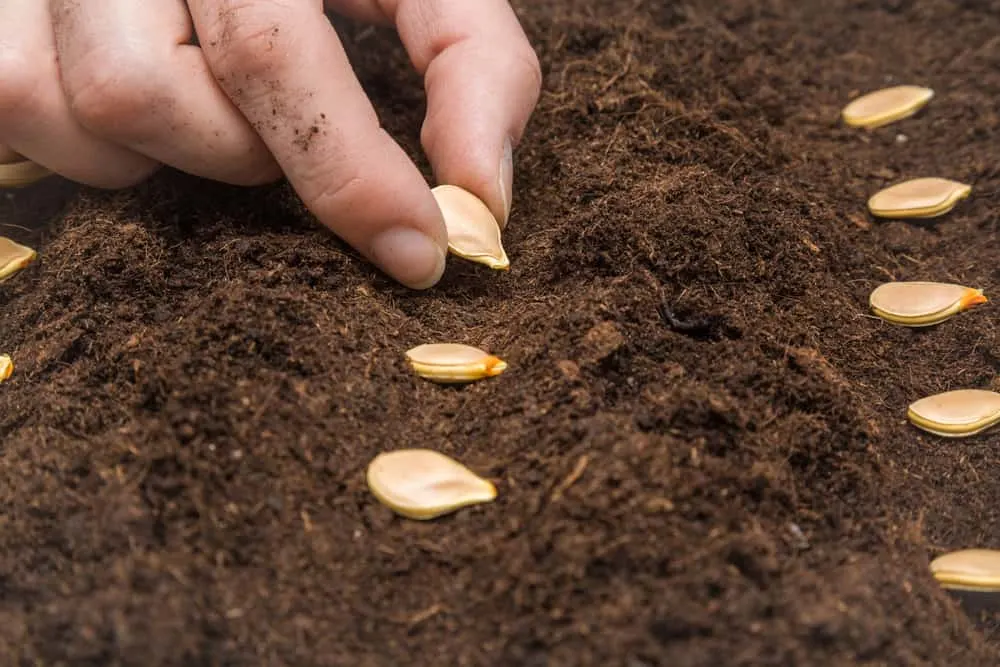
Another important thing to think about before choosing which types of squash to grow is whether or not you will be collecting your own seed.
If you are, it is important to understand whether the options you are considering are heritage or heirloom plants, or hybrid varieties.
Hybrid varieties will not ‘come true’ from seed – so the seeds you plant will not produce the same fruits – and may not even produce edible fruits at all.
Growing heirloom squash and pumpkin varieties is a great idea. It will allow you to collect your own seeds, and ultimately, to breed plants that are even better suited to growing in your area.
It will also allow you to contribute to efforts to maintain genetic diversity in our food crops, and increase biodiversity.
But remember – crops will cross-pollinate.
If you wish to retain seeds from a particular type and variety (and don’t want to breed new hybrids) then you will have to keep that squash crop isolated from other plants in the same family.
This is definitely something to bear in mind when choosing which types of squash to grow.
Other Things to Consider When Choosing Which Types of Squash to Grow
In addition to thinking about where you live, the conditions to be found there, and whether you want to choose heritage or hybrid varieties, you should also consider:
- How much space is required to grow each option (and how much space you have available).
- The size of fruits produced.
- The overall yield that can be expected from each option.
- The flavour and other characteristics of the squash in question.
- How, and how easily, the fruit can be processed and (for winter squash and pumpkins) how well they store, and how long they can be stored.
So, now we’ve covered the basics of choosing types of squash to grow in your garden, here are some of the options that you might be able to consider:
Summer Squash
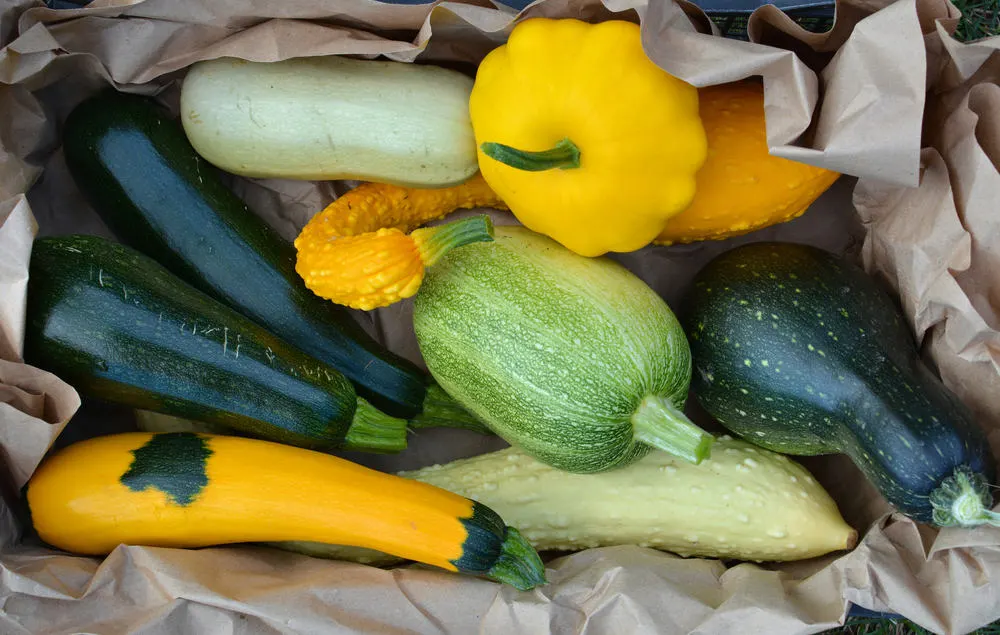
First of all, lets take a look at some of the varieties of summer squash that you can grow in your garden.
All summer squash are frost-tender, warm-season annuals.
They are usually started as seedlings indoors, and then transplanted to their final growing positions (in temperate climates) once all risk of frost has passed and the soil has warmed sufficiently.
Generally speaking, planting out is undertaken around a month after the last frost date.
They should be grown, generally speaking, in fertile, moisture retentive yet free-draining soil, and have fairly high nutrient and water needs.
Some vining squash are best grown against trellising and all can be supported for space-savings.
All squash can often be good companion plants – they provide good ground over and help retain soil moisture.
One of the most common companion planting schemes or polycultures for squash is the ‘three sisters’ planting plan.
This plan, utilised by Native Americans and often now included in permaculture garden designs, involves planting squash or pumpkins around corn and beans.
Nasturtiums can make good trap crops for pests that can plague squash, and can benefit the plants when grown nearby.
Summer squash are squashes that are usually harvested while they are immature, and the rind is still tender and edible.
Most are varieties of Cucurbita pepo, but not all Cucurbita pepo are considered to be summer squashes.
1. Zucchini
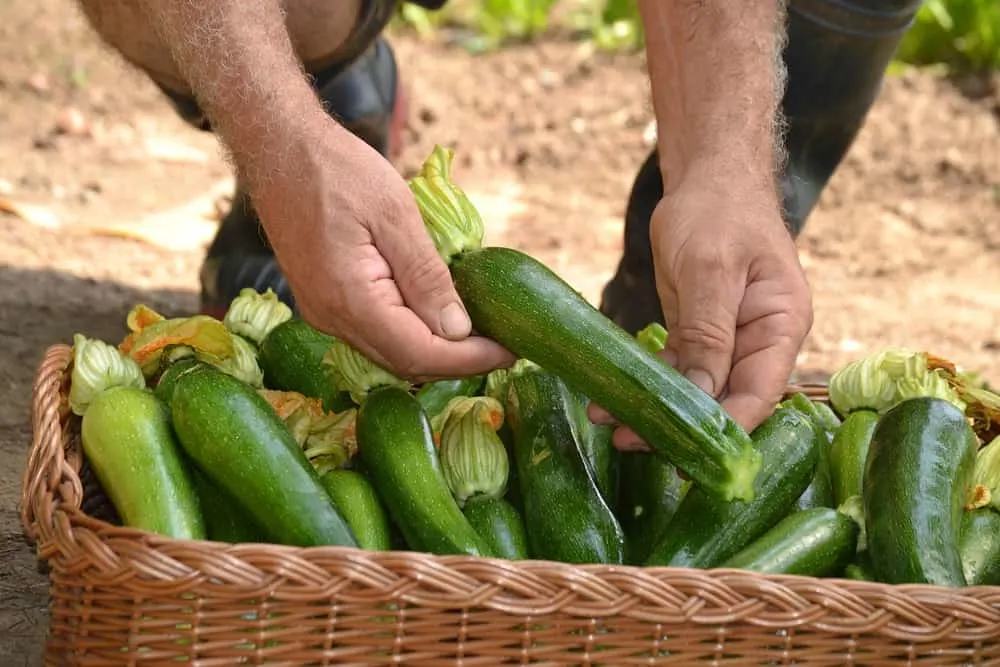
Green zucchini, also known as courgettes, are one of the most common summer varieties. They are a great choice, and can be grown in a wide range of gardens, in a wide range of climate zones.
There are plenty of heritage varieties to choose from, as well as more modern hybrid types. The flesh is generally of average sweetness and the flesh is moderately firm.
Zucchini are best harvested when they are young and small.
As they grow they become rather watery and less flavoursome and can become very large marrows by the end of the season. Harvesting regularly while the zucchini are small will help to ensure that fruits continue to form over a longer period.
All zucchini are ideal for ‘spiralizing’ to make zucchini noodles.
A spiralizer could be a good investment if you plan on growing lots of these in your garden, since making noodles, or spaghetti from zucchini is a great way to use up a glut of the fruit.
To ring the changes you could also consider growing some yellow zucchini varieties.
These have all the same characteristics as green zucchini, but yellow fruits, which some consider makes them easier to spot and harvest before they get too large.
There are also other hybrid zucchini varieties that are striped with yellow and green. When small, these different hues can make your zucchini look great in a salad.
2. Costata Romanesco Zucchini
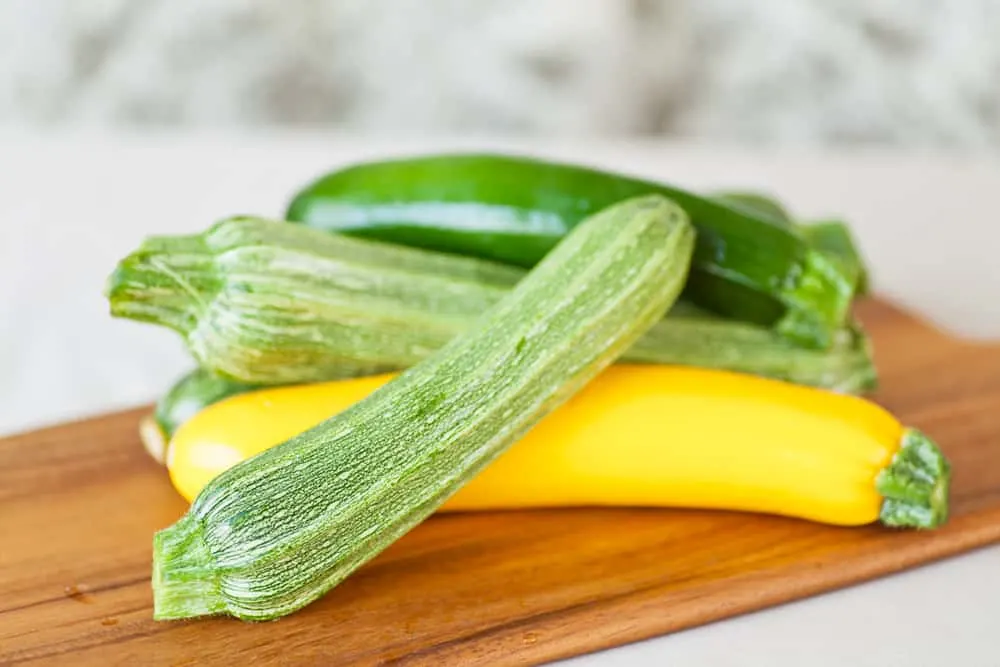
This Italian heirloom zucchini is a distinctive option, with lighter green or whitish ribs running lengthways down the green fruits.
Like other zucchini, the skins are soft enough to eat.
Typically, the fruits will grow to around 15 inches in length, but are typically harvested at around 6 inches.
It has a gentle nut-like flavour with a lingering sweet taste, and can be delicious eaten both raw or cooked in a range of recipes.
3. Zephyr Squash
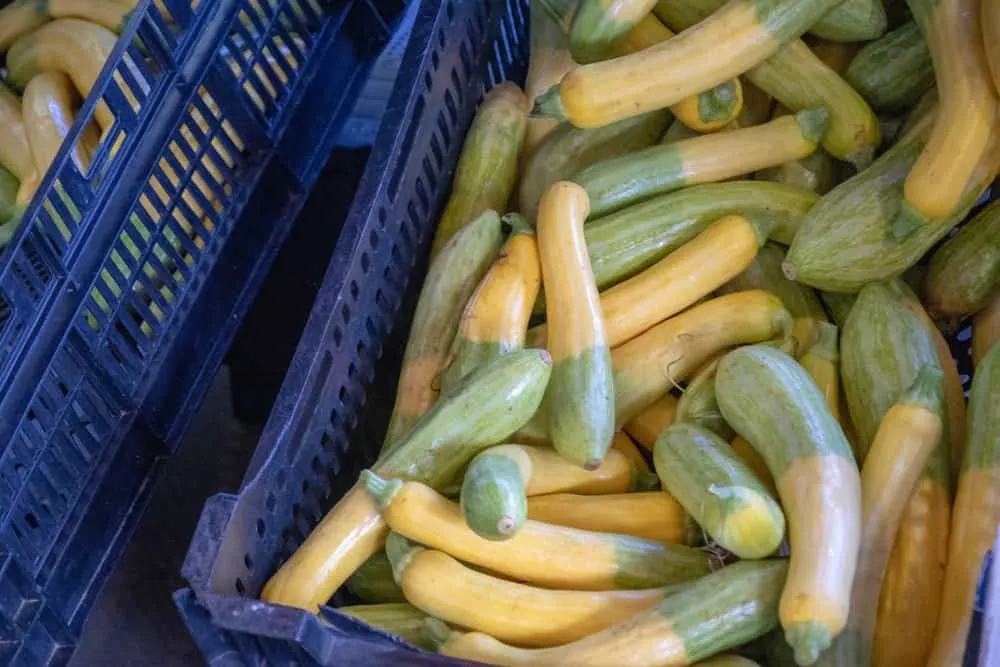
Zephyr summer squash are two-tone fruits that are rather distinctive.
They are straight and fairly long, with yellow on the top and pale green towards the bottom.
The skin of these fruits is somewhat tougher than a zucchini, but they are soft and tender inside and have a pleasant, somewhat nutty flavour.
4. Small, Round Zucchini and Summer Squashes
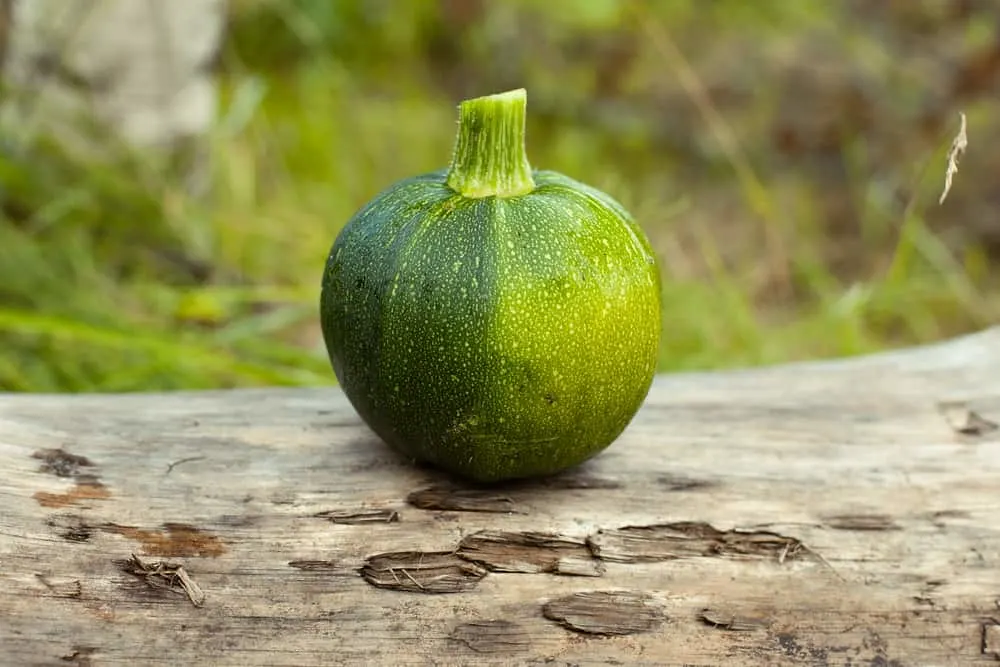
There are a range of small, round summer squashes and zucchini to choose from. Some are heritage varieties, and some are hybrid types.
Small, round zucchini are exactly like regular zucchini in taste and characteristics, but their shape makes them ideal for stuffing, or for using a serving bowls for soup.
Other small, round summer squashes may have tougher skin, and different taste and texture, but can also be used in the same way.
5. Patty Pan
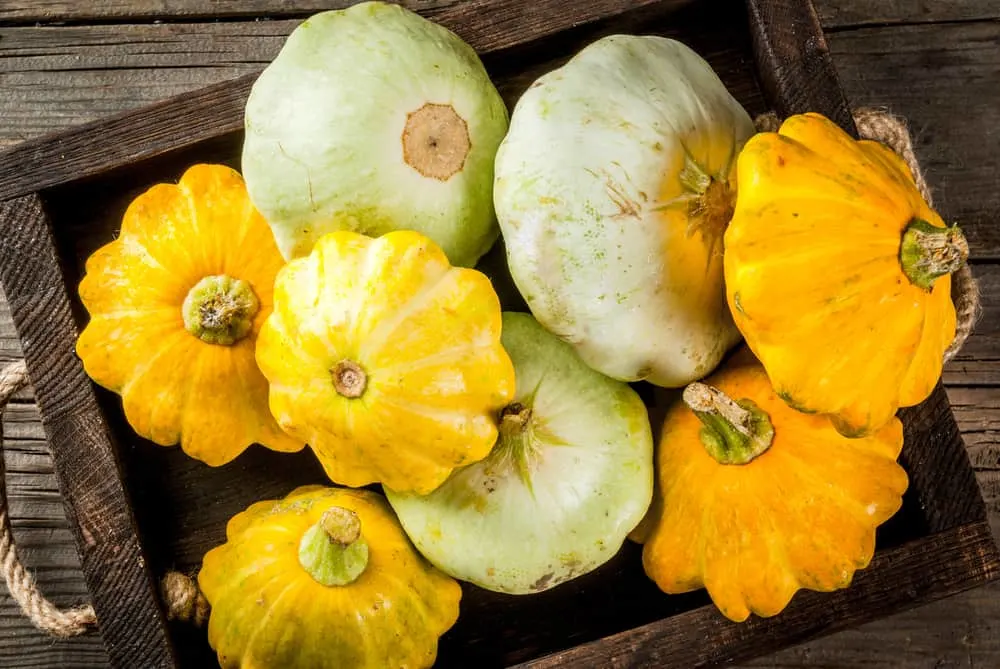
Patty pan squashes are small summer squash that look like little UFOs with scalloped edges around the middle.
These squash come in a range of colours.
Most often dark green, light green or yellow – though all taste more or less the same.
One of the good things about these squash is that they are tougher than other types of summer squash. This means they can withstand longer cooking times at higher temperatures.
6. Straightneck Squash
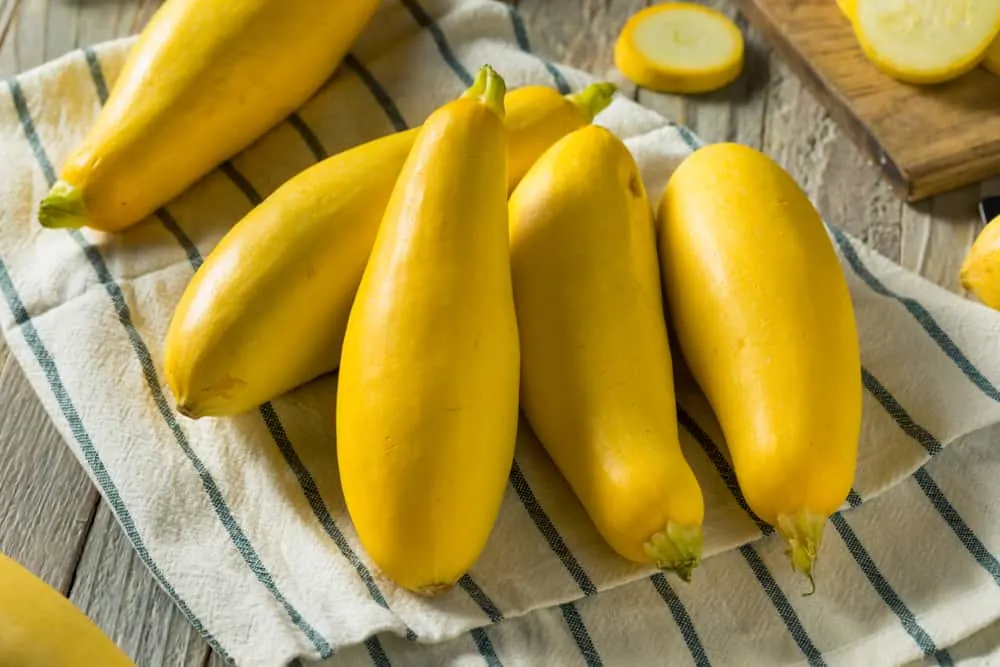
Straightneck squash are named for their long, straight shape. They are another group of cucurbita pepo types that were believed to have been domesticated in the eastern United States.
They are usually yellow in colour, and have a watery and mildly sweet flesh, and tender, edible skin.
This type is sometimes also called ‘yellow squash’ but this can also be the name used to refer to other types of summer squash.
7. Crookneck Squash
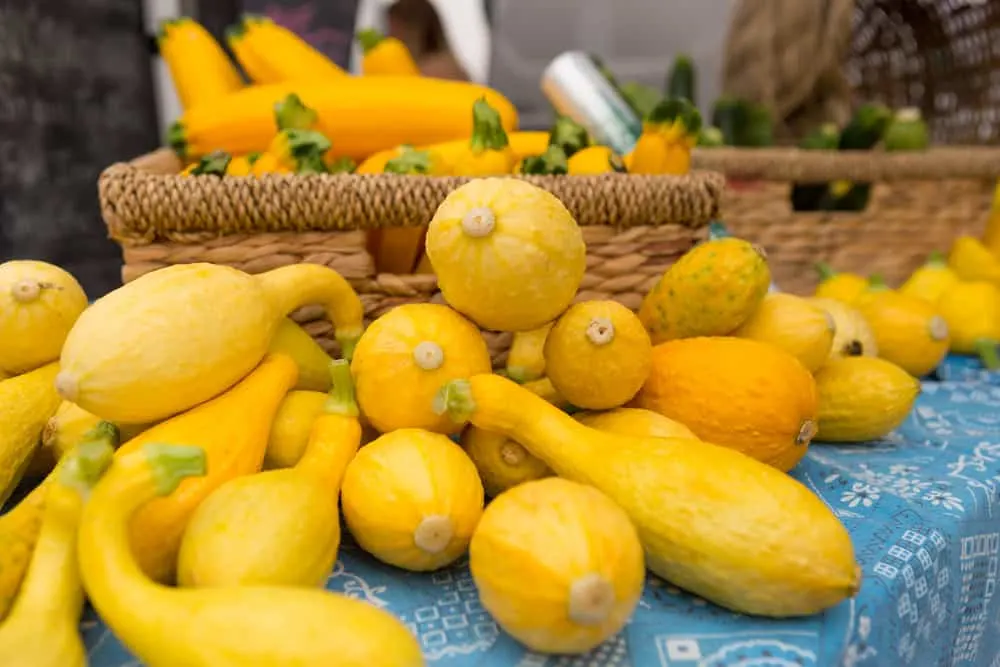
Crookneck squash are sometimes also referred to as yellow squash. As the name suggests, they have a bent shape, and are narrower at the top end than at the bottom.
The yellow skin can be either smooth or bumpy.
This summer squash is a bushy type, and should not be confused with crookneck cultivars of cucurbita moschata or the vining summer squash ‘Tromboncino’.
Generally, these are harvested immature, when less than 2 inches in diameter.
However, even immature, they tend to be a little tougher, and have a milder taste than other summer squashes.
8. Cousa Squash
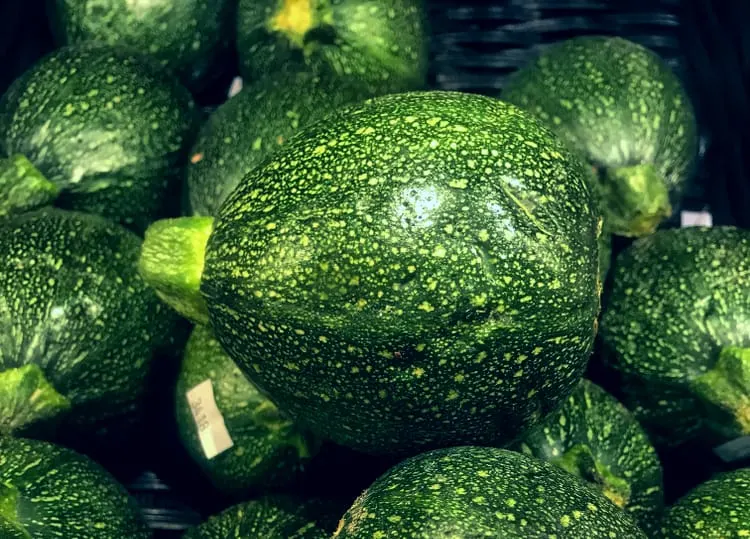
The Cousa squash is very similar to the zucchini, though usually a little more bulbous in shape. It is a type that originally comes from the Middle East, and it is common in Lebanese and Syrian recipes.
It tends to be a little sweeter and more tender than zucchini and has a very thin skin.
Often, cousa are cored and stuffed in recipes from the region. You can do this with a knife or apple corer, but to make things easier you could also consider purchasing a special zucchini corer.
9. Luffa
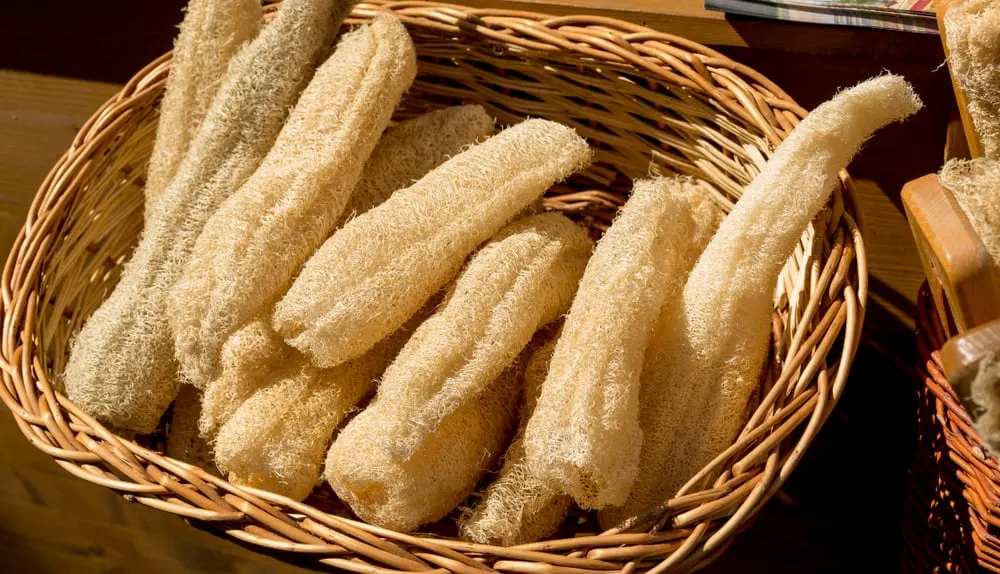
The luffa squash, or loofah gourd, is an unusual squash variety.
When young, the plant produces ridged squash that taste similar to a zucchini.
Leave the fruits to fully mature and dry, however, and the skin can be cracked away to reveal a scratchy, latticed natural loofah that is used in the bath or shower, or for washing dishes.
Winter Squash & Pumpkins
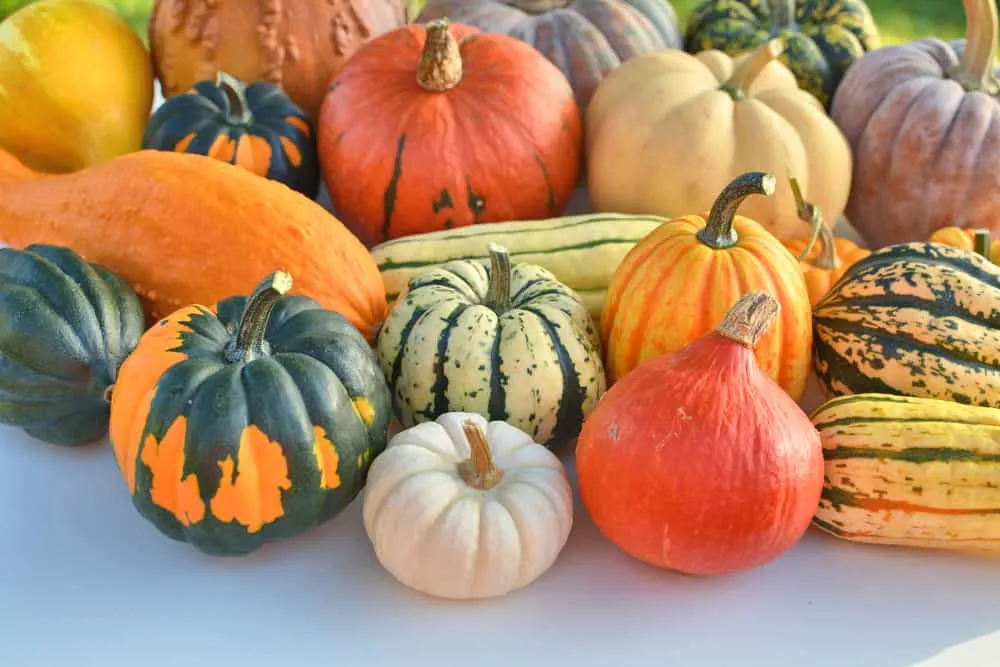
Now we’ve covered some of the popular types of summer squash, let’s take a look at some of the winter squash and pumpkins you could consider growing in your garden.
Like summer squash, winter squash and pumpkins are generally planted once the soil has warmed in the spring.
Unlike summer squash, however, these types are usually left on the plants to mature fully before they are harvested in the fall.
They will like similar growing conditions to summer squash, but tend to be vining in habit, and often more vigorous.
Winter squash and pumpkins can also be supported/ trained in order to save space in the garden, and will also respond well when companion planted with corn and beans in the ‘three sisters’ planting scheme.
Unlike summer squash, which are harvested young and tender, with these types you should wait to harvest until the skin has thickened and hardened, and the surface dulled to a matte rather than a shiny finish before you cut the stem just above the fruit and leave the squash or pumpkins to cure before storing them for winter.
Winter squashes can belong to a number of different species within the genus Curcurbita.
These can include pumpkins, which are commonly Cucurbita pepo but which can also be derived from Cucurbita maxima, C. argyrosperma and C. moschata.
A number of types are referred to interchangeably as winter squash or pumpkins.
Here are some of the winter squash or pumpkin types that you could consider:
10. Butternut Squash
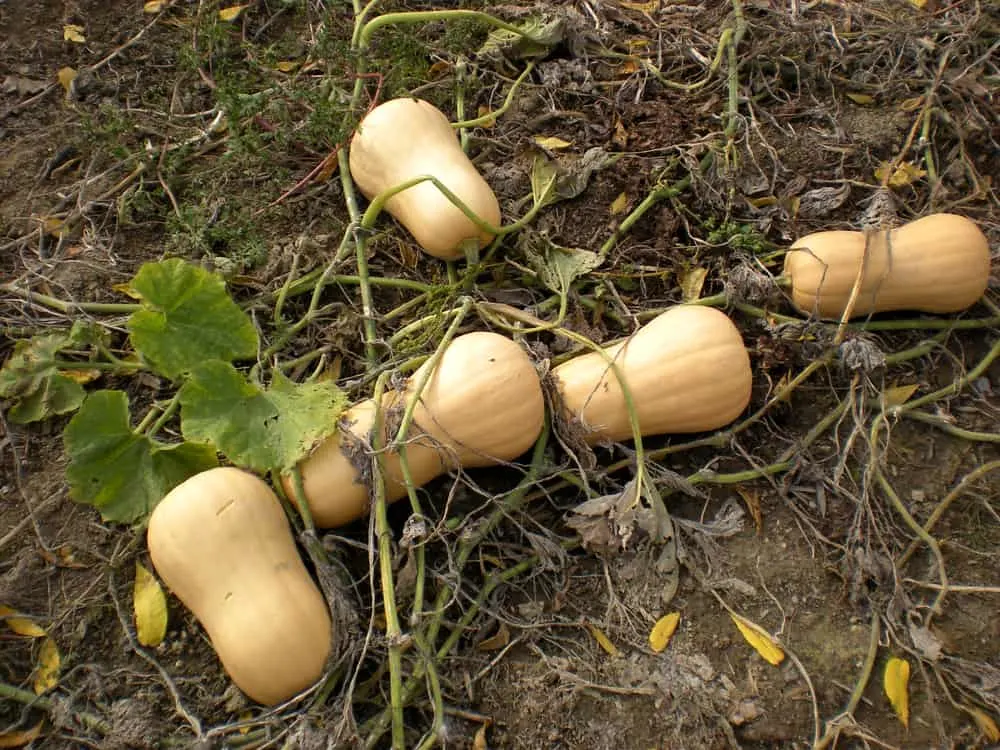
One of the most easily recognised squash is the butternut squash.
It is a pale orangey-yellow colour and has a pear-like shape. A bulbous bottom houses the seeds and a thinner neck protrudes above.
The more orange the exterior, the drier, riper and sweeter the flesh will be.
The taste and texture of the cooked flesh is similar to sweet potato, and it is a good choice for use in soups and blended recipes.
The skin is quite easy to peel (but can be left on when roasting), and the whole butternut squash can store for up to three months.
11. Acorn Squash
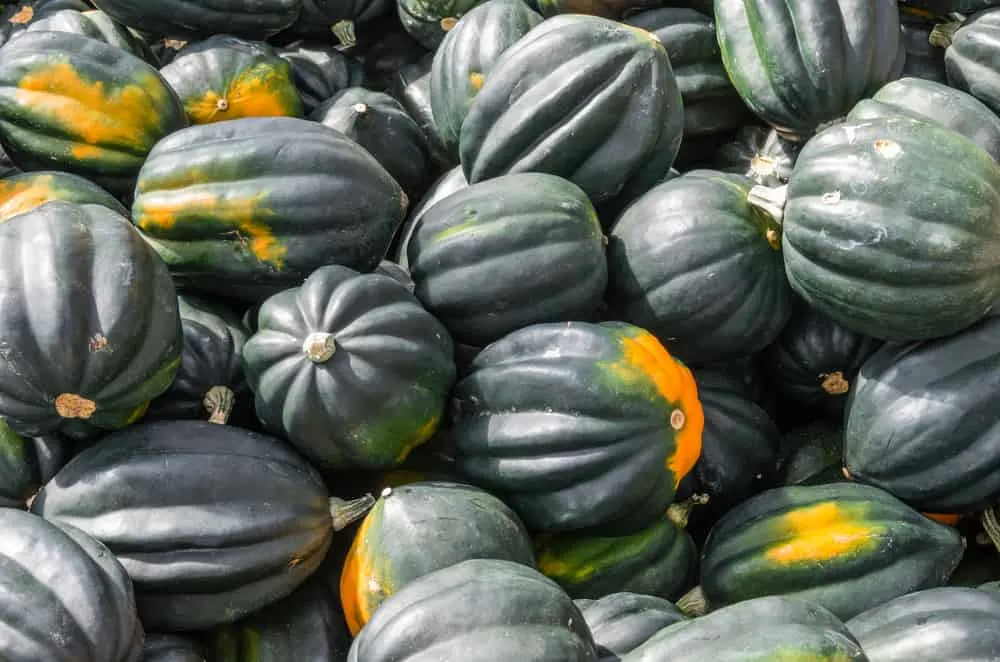
These small, round squash come in a range of hues, but are commonly darker green with orange markings.
Squash are best harvested before too much orange coloration appears, as the more orange the become, the tougher and more fibrous they will be.
The flesh is yellowish orange in colour and has a mild sweet and nutty flavour which makes them incredibly versatile. You can use these squash in a wide range of recipes.
However, it is best not to store these for more than a month.
12. Sweet Dumpling
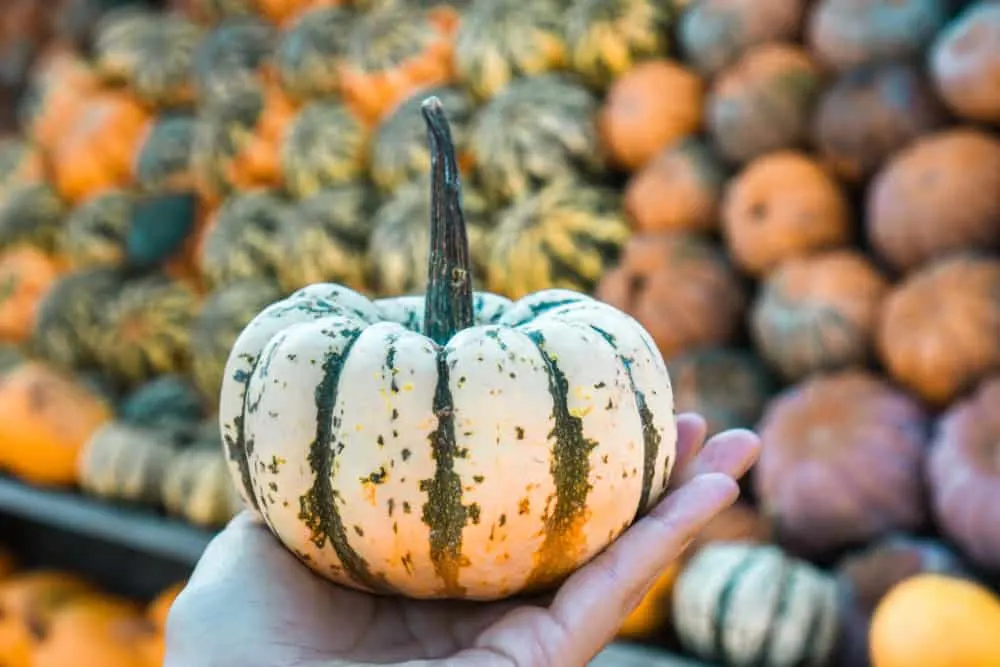
Sweet dumpling squash are small and compact in form.
They have whiteish-yellow skin with green striations, and the skin can also be eaten.
As the name suggests, this is a sweet squash, with a taste and texture when cooked that is similar to sweet potato.
Whole squash of this type can be stored in the right environment for up to around 3 months.
13. Kabocha
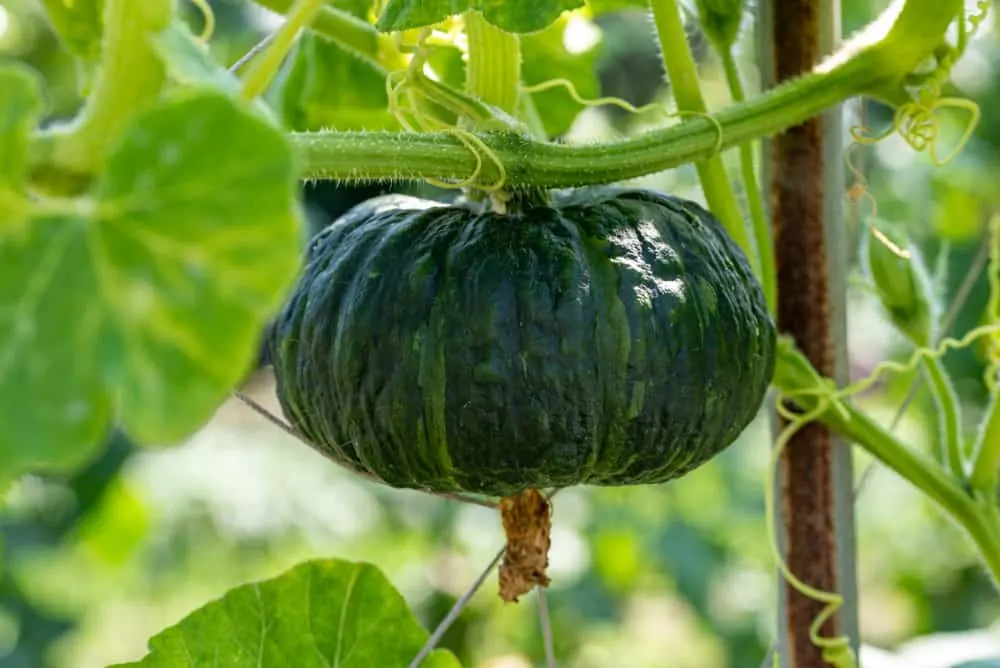
These winter squash are a Japanese variety that are also sometimes referred to as Japanese pumpkin.
They are fairly small and squat, and most often, have dark green skin. The flesh is bright orange and tastes like a cross between sweet potato and pumpkin.
In Japan, it is commonly cut into chunks for tempura, though it can also be used in a wide range of other recipes.
The whole squash can be stored successfully for only a month or so.
14. Red Kuri/ Uchiki
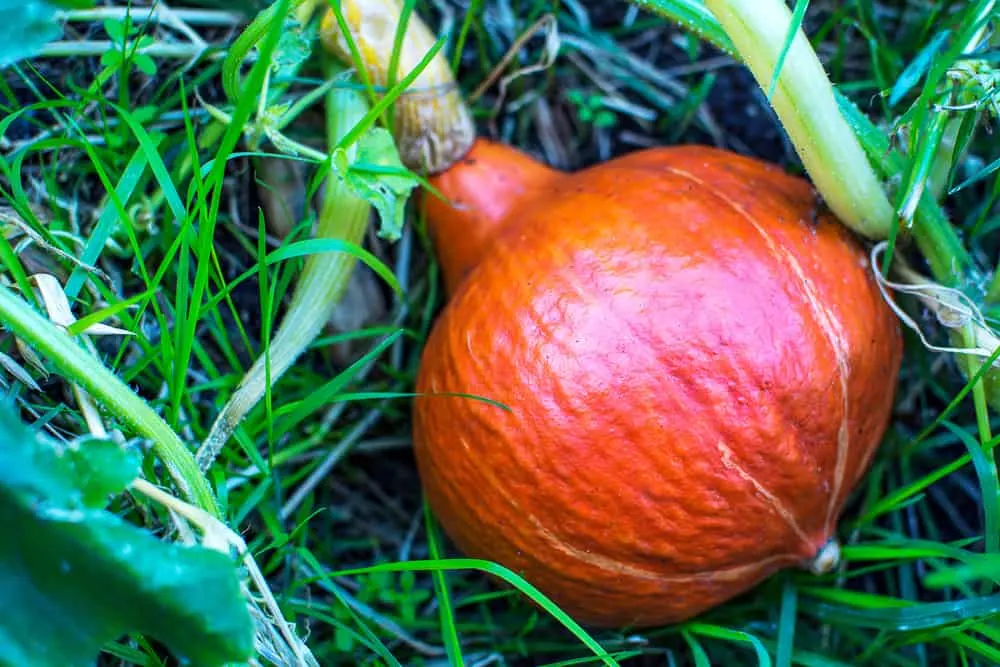
Another Japanese squash type is that of Red Kuri/ Uchiki. These smallish, onion-shaped winter squash can offer excellent yields in the right location.
They have a delicious, mildly sweet, chestnut-like flavour and are very versatile since the flesh has a dense texture that holds together well when cooked, but which can also be blended to a smooth puree.
This is technically one of the Hubbard group of squashes (see below)
15. Hubbard
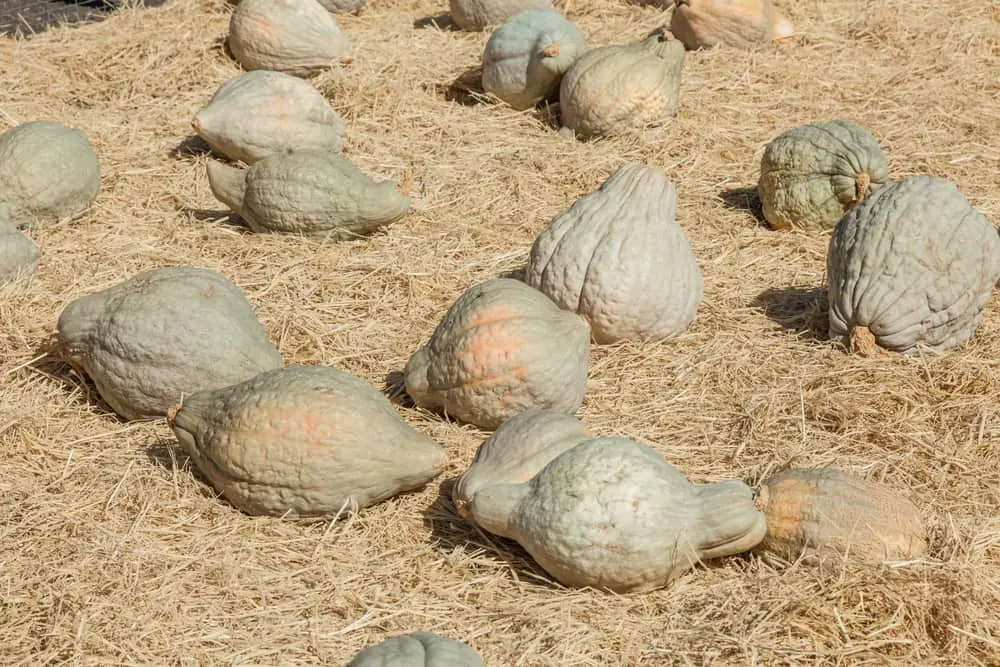
There are many different Hubbart type squash, which can vary quite a lot in their appearance and coloration.
Generally speaking, these types of squash are large in size, with thick, tough and lumpy skin and sweet, orange flesh.
Once the skin has been removed, this squash can be used in a wide range of different recipes.
With its thick skin, it is an excellent storer, and can be kept, in the right conditions, for up to six months.
16. Delicata Squash
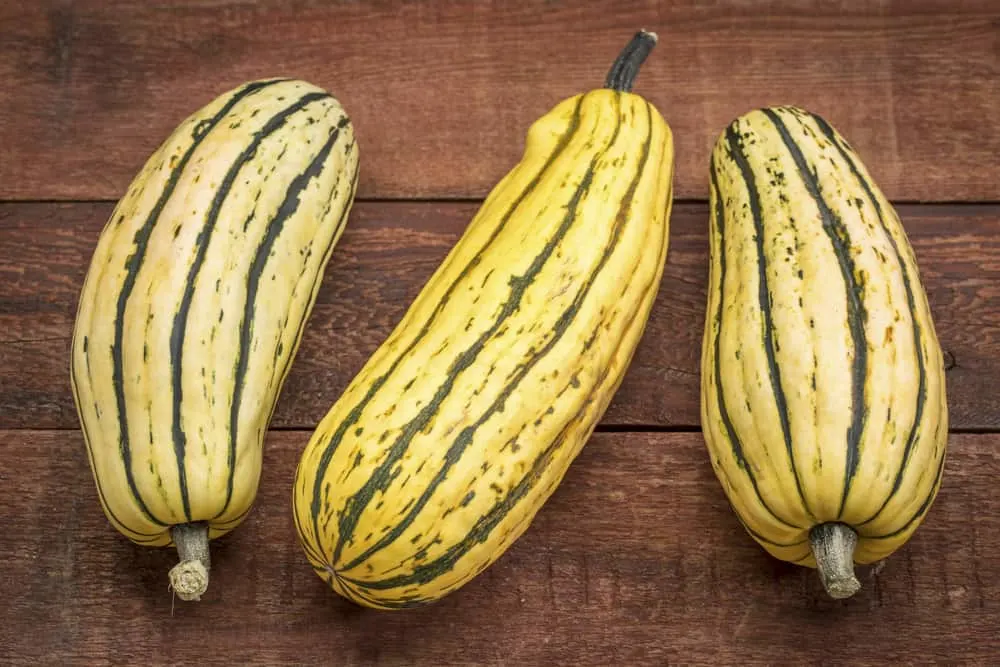
Also known as ‘sweet potato squash’, Delicata type is cylindrical in shape.
It has pale yellow and green striped skin, and a more delicate rind than many other squashes which makes it particularly easy to work with and prepare.
As the alternative name suggests, the flesh strongly resembles sweet potato.
The skin is also edible, and the shape means that delicata squash are often stuffed.
Whole squash of this type can be kept for up to three months.
17. Spaghetti Squash
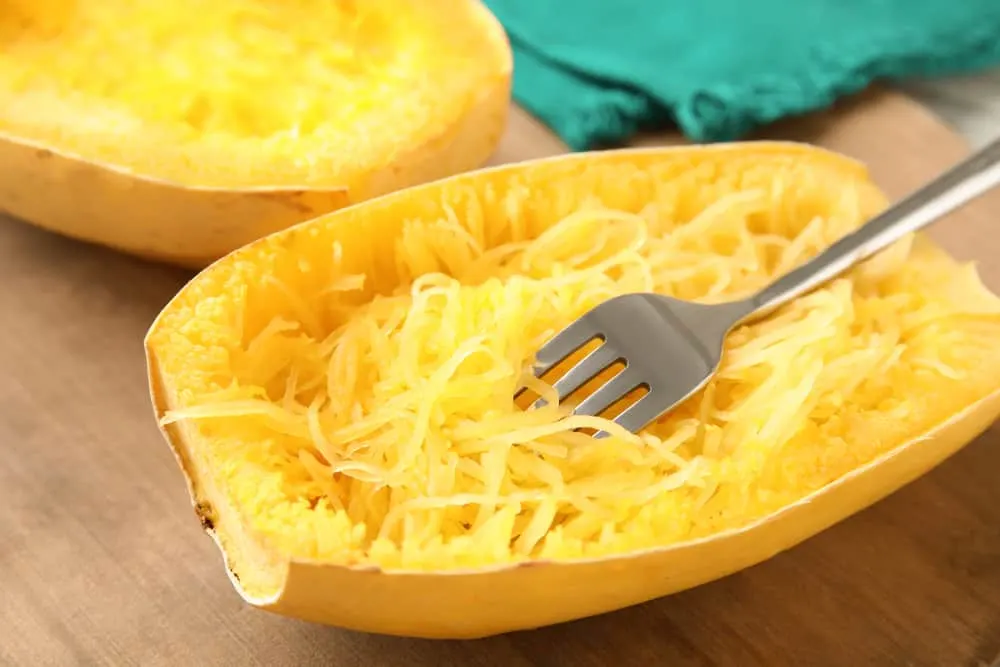
Spaghetti squash come in a variety of shapes, sizes and colours, but are frequently yellow to orange in colour.
The centre contains many large seeds and the flesh, when raw, is solid and similar to other squash. When it is cooked, however, the flesh falls apart into ribbons or strands.
These can be substituted as a low-carb, healthier alternative to spaghetti or noodles (no spiralizer required).
The whole spaghetti squash can be stored for a month or two in the right conditions.
18. Buttercup Squash
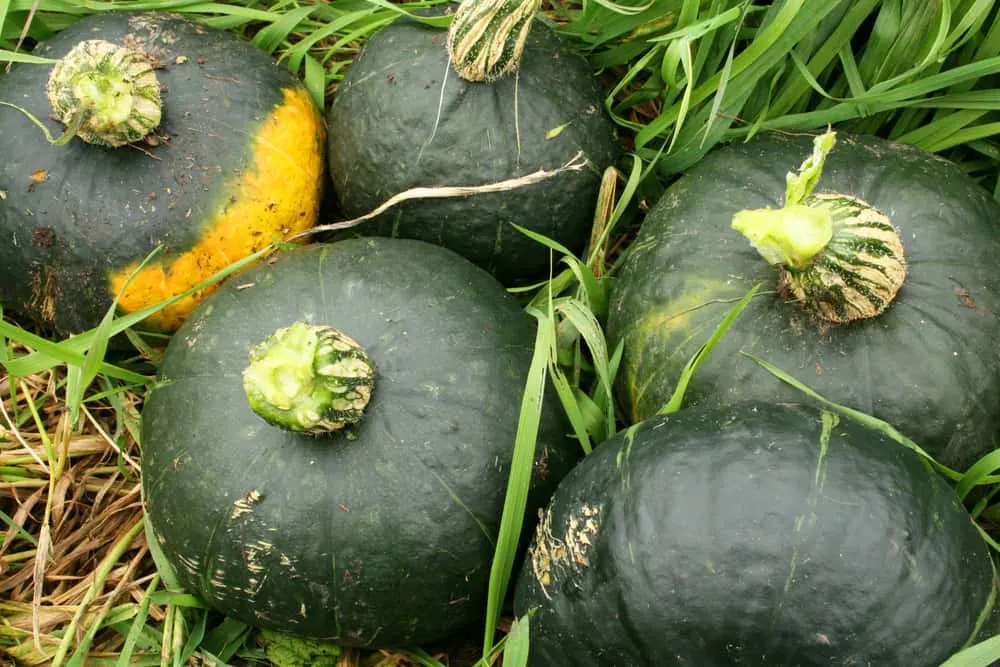
Buttercup squashes are a great choice for heritage growers, as there are a range of interesting cultivars to consider.
These types of squash are characterised by their squat, compact shape and form.
They generally have dark green skin with lighter striations, and are heavy, with dense, yellow-orange flesh.
The flesh is very mild in flavour and sweeter than many other types. It works very well baked or steamed, and can be mashed as well as an alternative to sweet potato.
These squash can be stored for up to three months.
19. Banana Squash
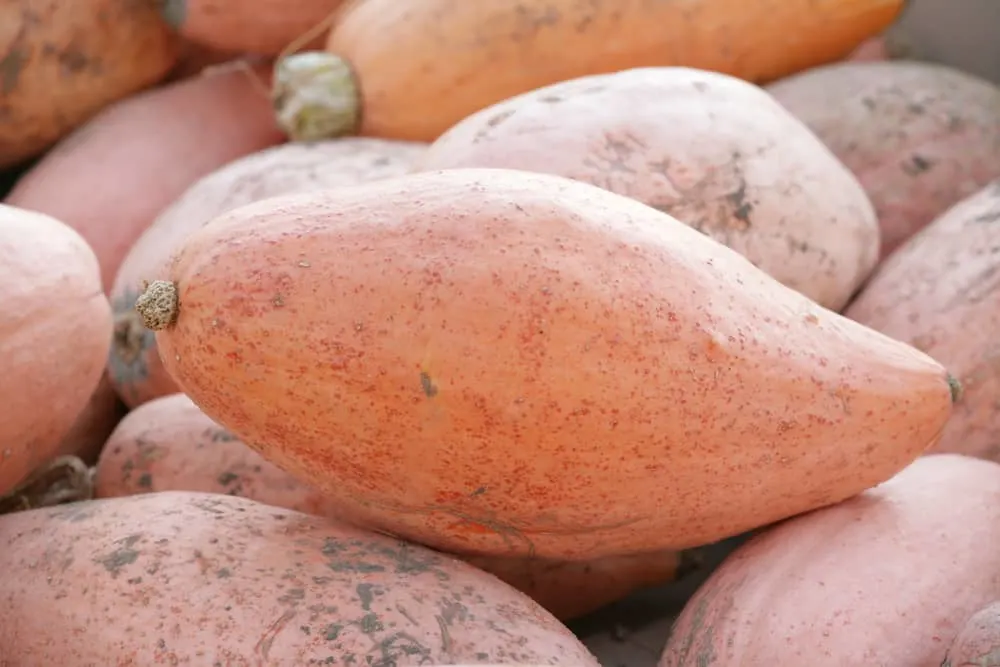
Banana squash are large and elongated in shape. There are a number of interesting heritage and hybrid varieties to choose from.
Some of these can reach a whopping size and weight.
The skin of these squash is usually orange, pink/red or blue in hue, though there are many variants.
When stored properly, whole banana squash can last for up to six months.
20. Turban Squash
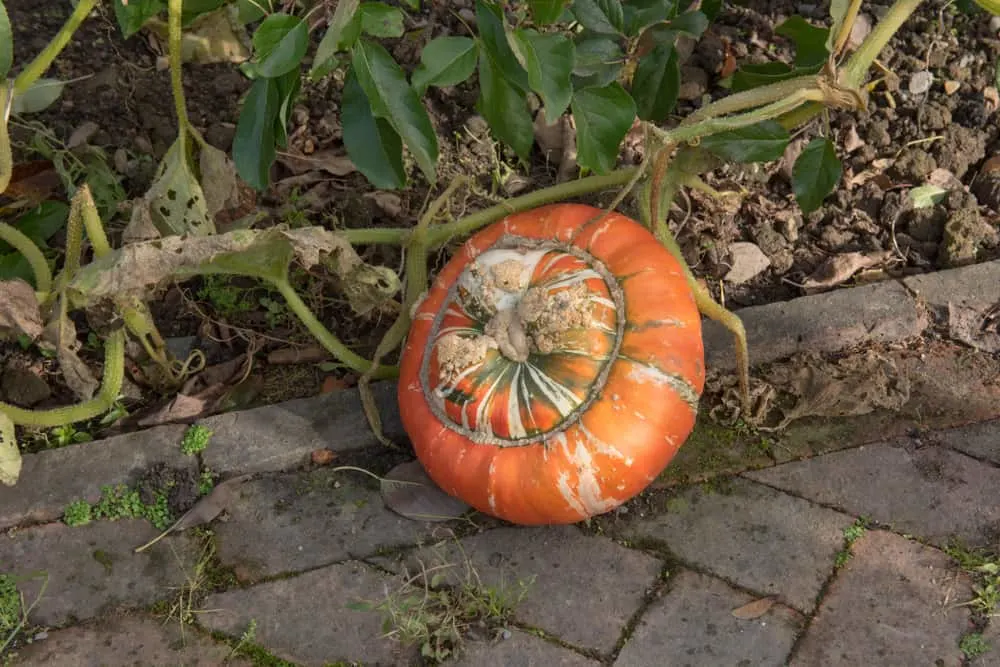
Turban squash all share in common their shape, which really does resemble a turban.
They have a smaller round protuberance at the blossom end perched above a larger rounded form.
These are very decorative squash which have bumpy skin in a wide range of colors.
Often they have many colours at the same time. But unlike decorative gourds, this type is also good eating.
It has a mild flavour that can pair well with a wide range of other ingredients.
21. Carnival Squash
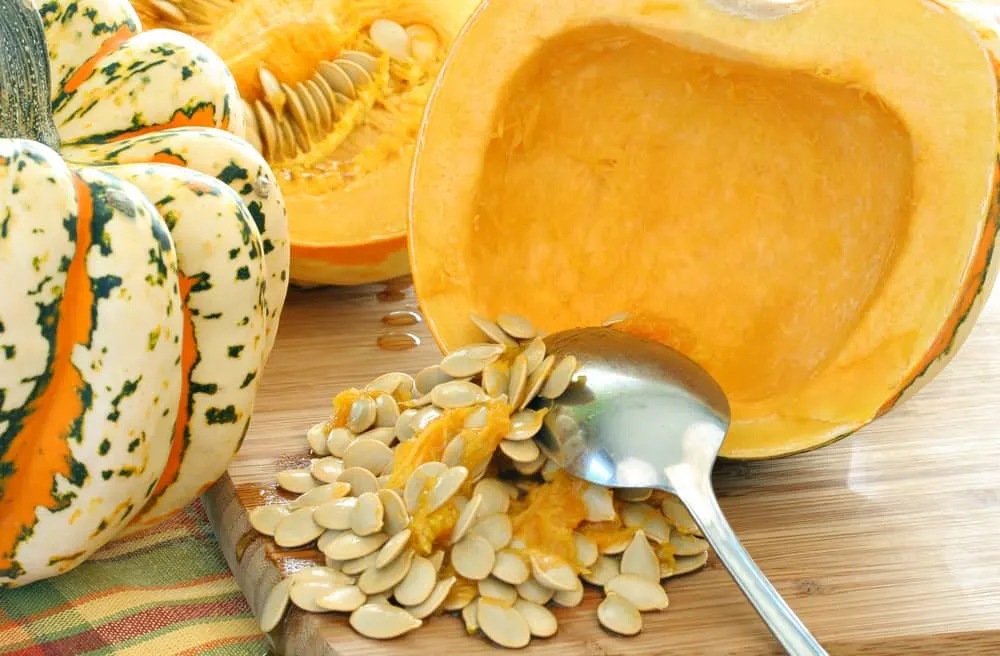
Carnival is one example of a common hybrid type. It is a cross between acorn and sweet dumpling squash.
These types have attractive stripy and variegated exterior skins, and a pale orange flesh that strongly resembles the taste of a butternut squash.
This type is great when roasted and added to a wide range of recipes, though it will store successfully for only around one month.
22. Field Pumpkins
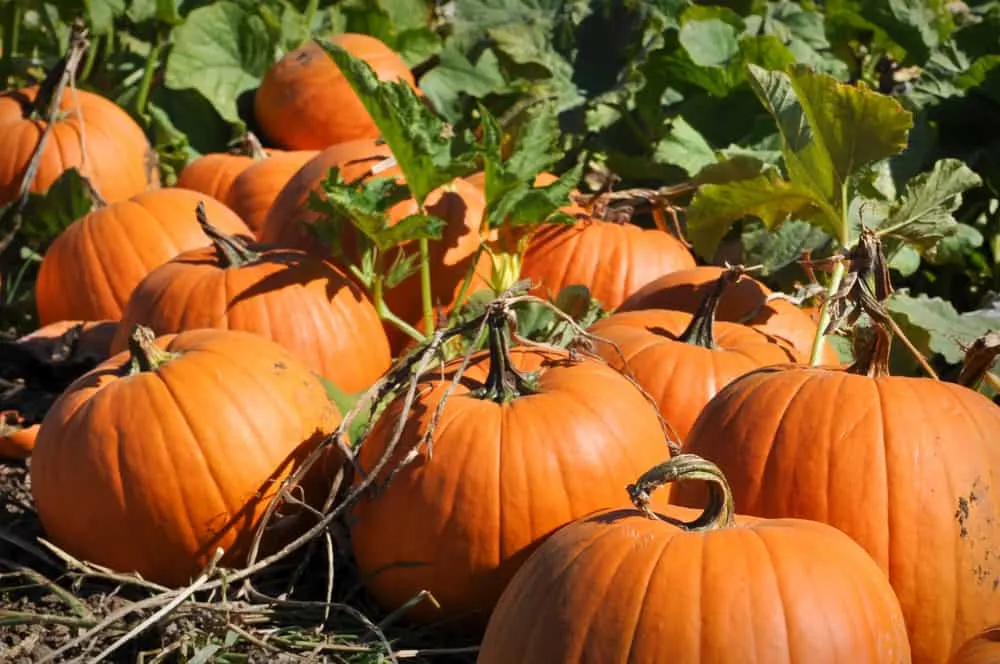
Field pumpkins, such as the Connecticut field pumpkin, is that traditional looking, round and bright orange pumpkin.
You know, the one that is commonly used to make jack o’ lanterns. If you do want to carve pumpkins at home, a pumpkin carving kit could come in handy.
Certain heirloom varieties of this type differ little from the winter squash grown by Native Americans in pre-Columbian times.
While they are large, and edible, it is worthwhile remembering that these types are not always particularly well flavoured.
So if you want more than just a carving pumpkin, select a cultivar that has been bred for good taste.
23. Pie Pumpkins
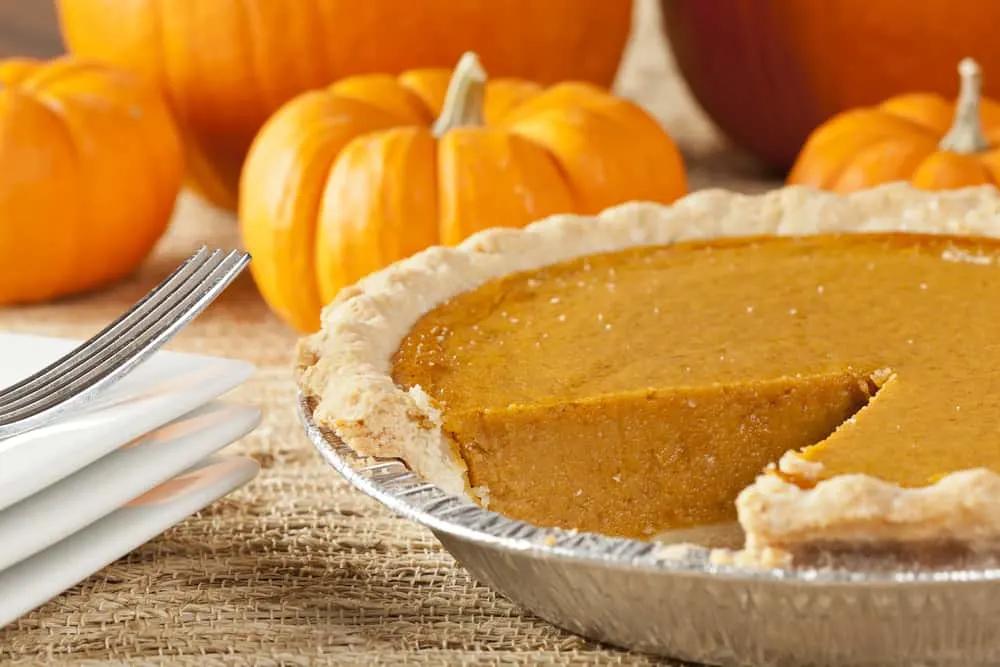
Pie pumpkins are smaller and much sweeter and better tasting than ordinary field pumpkins or jack o’ lantern pumpkins.
These are also known as small sugar pumpkins. Like their larger counterparts, these pumpkins have bright orange skin.
These smaller pumpkins, however, have rich and sweet pumpkin flavour. This means they are great for use in a huge range of recipes.
They are grown for flavour rather than size and uniformity.
24. ‘Cinderella’ Pumpkins
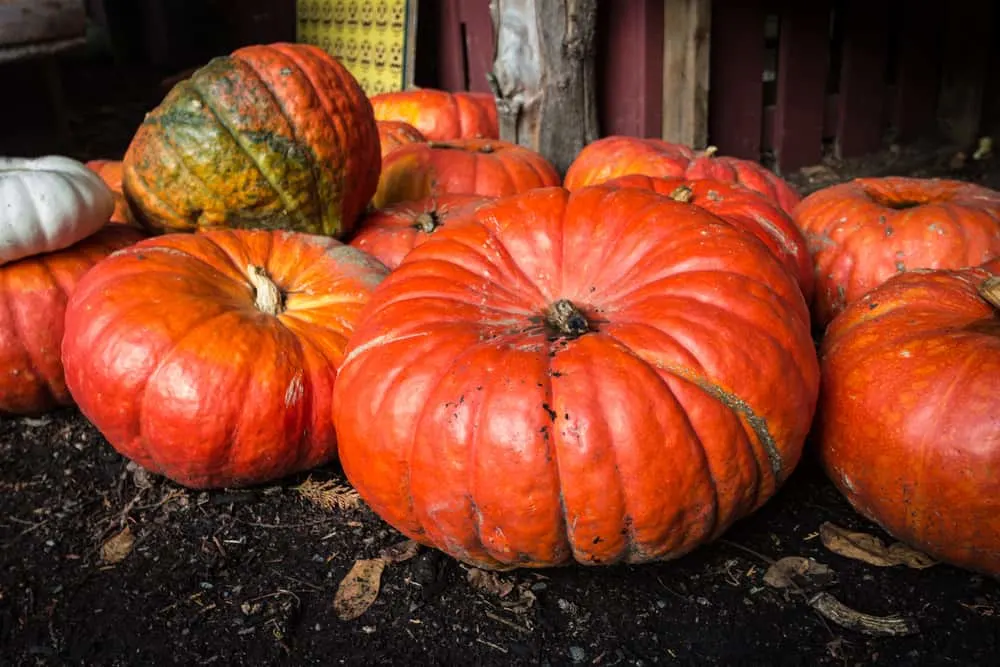
The French heritage variety ‘Rouge Vif d’Étampes’, Musquée de Provence and US variety ‘Long Island Cheese’ are deeply ridged yellowish, orange and reddish pumpkins.
They may give you a fairytale vibe.
The fairytale feel is largely down to the fact that pumpkins of this sort were clearly used as inspiration for the design of Cinderella’s carriage in the Disney movie.
While looking good, however, the flavour can be somewhat lacking in some cultivars.
25. Giant Pumpkins
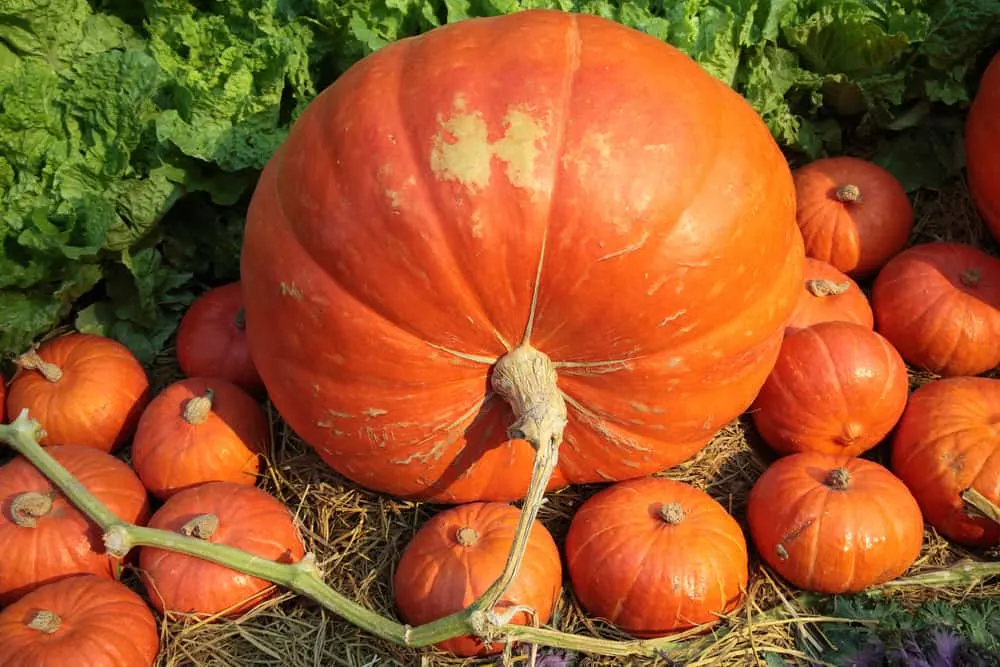
One final option if you want to grow a range of different types of squash in your garden is: go big. Very big!
Certain types of Cucurbita Maxima can produce fruits of over 100 pounds, and the largest have reached over 2,600 lbs.
‘Atlantic Giant’ is the variety from which most giants are grown, though there are several other cultivars you could consider.
Size rather than flavour is generally the primary concern with these types. But some, such as the ‘Pacific Giant’ variety, do have great flavour too.
These types listed above are just a starting point. But they should help you to find the right squash for you.
There is such a huge range of specific cultivars and variations that there is no way that they could possible all be listed in just one article.
A great place to start if you want to grow these fruits where you live is with your friends and neighbours. Ask them which varieties they grow so you get a better idea of what will do well where you live.
Alternatively, speak with gardening experts at your local garden centre or plant nursery (or to farm workers/ farmers living nearby).
That way, you will have a better idea which types of squash you should go for for the best results.
Squash can be an incredibly useful crop to grow.
Growing them could be one more step on your journey towards eating delicious produce from your property all year round.
Pin This To Save for Later
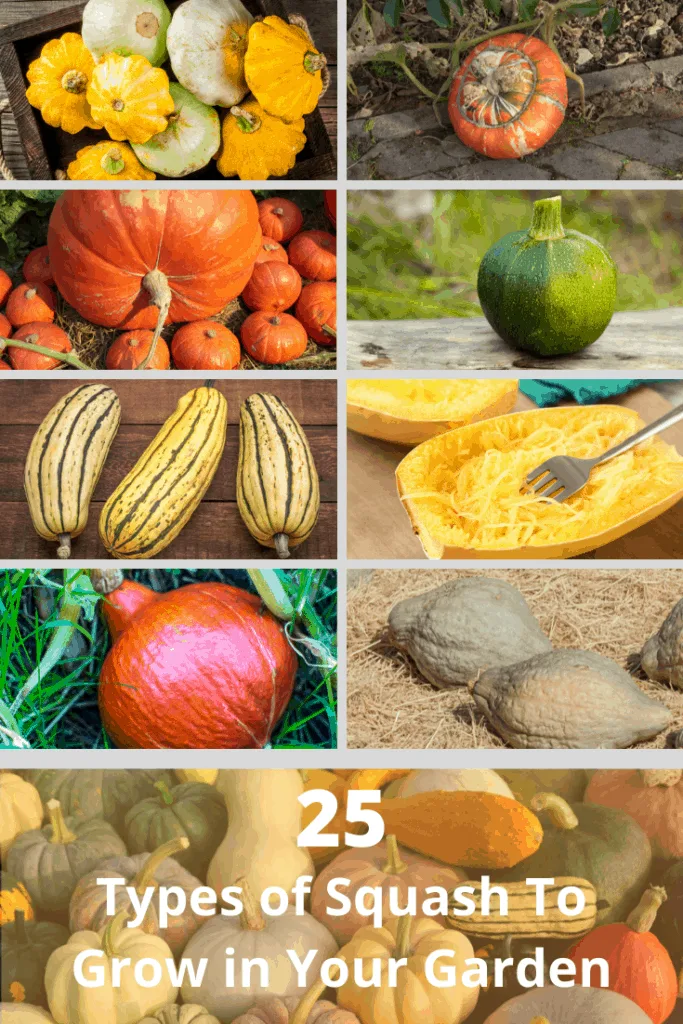

Get the famous Rural Sprout newsletter delivered to your inbox.
Including Sunday musings from our editor, Tracey, as well as “What’s Up Wednesday” our roundup of what’s in season and new article updates and alerts.


